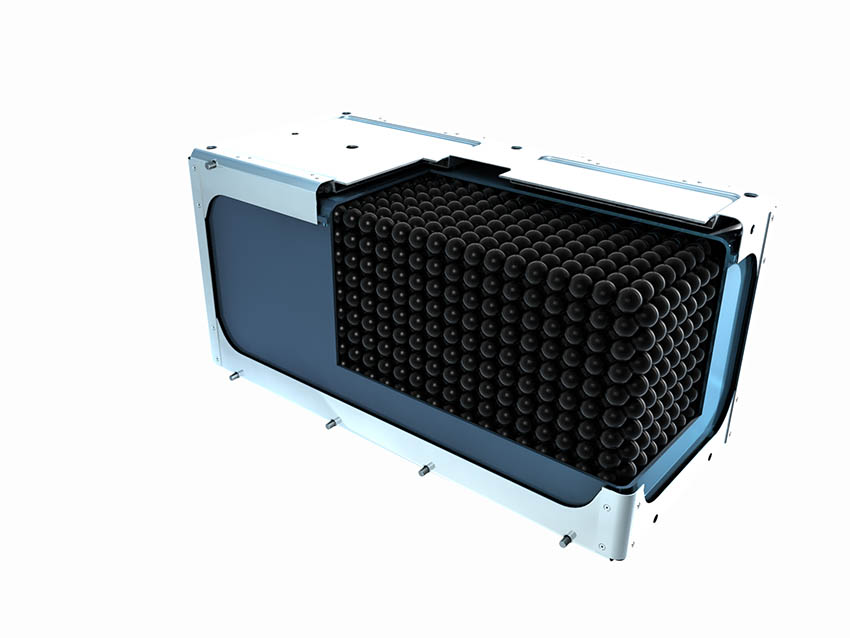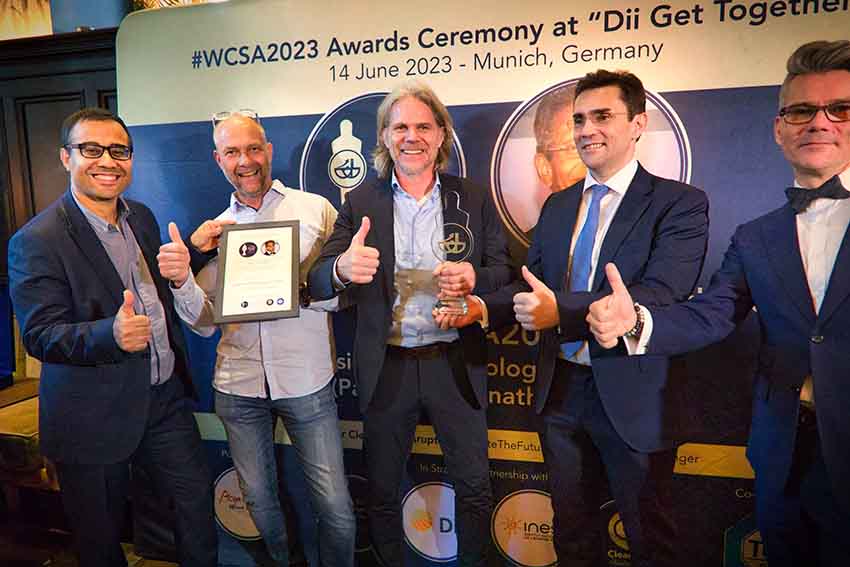water stuff & sun is a German hydrogen start-up based in the Munich area that is developing a disruptive storage and infrastructure technology for renewable energy: The hydrogen battery – a 2-in-1 storage and application solution – is the first technology to combine the safe and easy distribution of hydrogen from renewable energy sources with its integration into various applications in a very cost-efficient way.
The hydrogen battery cells – called SFEERS – are spherical high-pressure tanks filled with gaseous hydrogen. At the heart of each SFEER is a micro valve system integrated into the carbon fiber shell that regulates hydrogen flow like a conventional valve, but at a much lower cost and weight. The hydrogen cells combine two well-proven technologies – conventional high-pressure tanks and the microvalve system derived from satellite technologies.
The hydrogen battery aims to be a solution to the still unresolved challenges of the energy transition on how to store large amounts of renewable energy and transport it to the consumer – even though renewable energy can already be produced more cost-efficiently than energy from fossil fuels. The development of the hydrogen battery provides a holistic solution to this challenge: it is both a transport container and a storage device for hydrogen and can be used in both mobile and stationary applications.
The company’s goal is to make storage and use of renewable energy simple, safe, and less expensive than today’s approaches – green hydrogen will finally be competitive with fossil fuels.

Easy Engineering: What are the main areas of activity of the company?
water stuff & sun: The H2 battery is a new energy or hydrogen carrier that provides a much more efficient infrastructure than existing H2 storage solutions. The hydrogen battery serves and simplifies the entire hydrogen value chain, eliminating the need for multiple compression or conversion steps and different storage means used between energy production and hydrogen use. Furthermore, low infrastructure investment requirements allow the hydrogen battery system to be scaled up quickly. This means, for example, that green hydrogen for trucks, drones, planes, and other applications can be supplied at considerably lower cost than with the hydrogen supply chain that is currently available. We plan to enter the truck market due to the expected high CO2 savings and the upcoming changes in the transportation industry.
Due to the shape, size, and functionality of our SFEERS, the hydrogen battery also provides advantages directly in the application, for example in the vehicle: A higher storage capacity and more efficient use of vehicle space than conventional high-pressure hydrogen tanks result in a longer range, which is another key advantage in building the infrastructure. Splitting the hydrogen into many small units multiplies the safety functions and makes our solution many times safer than models currently on the market.
E.E: What’s the news about new products?
water stuff & sun: We are in the development stage at the moment: The core component of our technology is a microvalve system consisting of several subcomponents. We successfully tested the first two stages of a five-step pressure regulator that will be able to control the hydrogen release in steps from 1000bars down to a few bars. The pressure regulator is only a few micrometers in size and is the core component of a microvalve system that controls the gas flow inside a silicon chip measuring only 4x4x2 mm. The miniature pressure regulator will be integrated into tennis-ball-sized carbon fiber high pressure storage cells, the SFEERS that store compressed gaseous hydrogen inside the hydrogen battery.

E.E: What are the ranges of products?
water stuff & sun: The light weight and flexibility of the SFEERS allows for a highly modular system, so that the hydrogen battery can be customized to all kinds of energy consuming applications powering hydrogen fuel cells or hydrogen combustion engines of all sizes. Apart from the hydrogen battery for trucks, we are also analyzing the application of SFEERS in the aerospace sector and plan to develop the first prototypes for drones/aircraft together with our partners.
E.E: At what stage is the market where you are currently active?
water stuff & sun: In heavy duty vehicles and machines still the diesel engine is dominating however hydrogen is considered the fuel that propels hydrogen combustion engines and hydrogen fuel cell vehicles and machines that are currently in development. Aviation also considers hydrogen to fuel short and mid distance airplanes and drones.
E.E: What can you tell us about market trends?
water stuff & sun: Regarding the hydrogen market we need to differentiate between hydrogen for energy transport and hydrogen as fuel in mobility. Our solution focuses on fuel in mobility where we can observe two major trends: Firstly, for compressed gaseous hydrogen, the OEMs and infrastructure providers tend towards 700 bar solutions. Our solution unlocks gaseous hydrogen for long haul trucks and improves storage performance compared to all other approaches and at the same time simplifies hydrogen infrastructure that allows lower hydrogen fuel cost.
E.E: What estimations do you have for 2023?
water stuff & sun: Currently, the market for hydrogen technology is in its nascent phase and needs further development to reach its full potential: There is no efficient technology for H2 storage and distribution available to decarbonize several sectors and the lack of hydrogen infrastructure is still a major obstacle for mobile applications in particular.

Road transport is responsible for one third of all final energy consumed in the EU. The current EU HDV fleet is run almost entirely on internal combustion engines which are predominantly fueled by fossil fuels. Yet, the EU regulation setting CO2 standards for heavy-duty vehicles obliges manufacturers to reduce average fleet emissions of new heavy-duty vehicles (HDVs) within regulated vehicle by up to 30% by 2030.
Therefore, the hydrogen battery is coming at the right time to further increase the market pick up of hydrogen applications and the development of hydrogen distribution infrastructure. In 2023 we are planning to complete a 1st system prototype integrating all developed components to demonstrate 1st hydrogen batterie supplying hydrogen.

